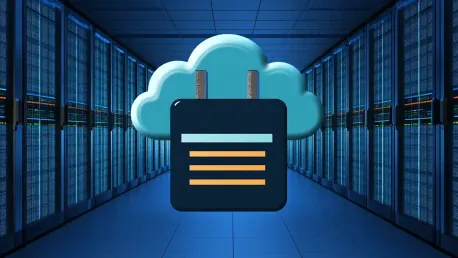Unmanaged long-lived cloud credentials have emerged as a significant security concern for nearly half of the organizations today. These credentials, often overlooked or mishandled, present substantial security vulnerabilities that can lead to severe data breaches. Despite advancements in cloud security technologies, the persistent issue of old and unused credentials continues to plague businesses. This article delves into the critical aspects of these security risks, informed by Datadog’s “State of Cloud Security 2024” report.
Prevalence and Risks of Long-Lived Credentials
Widespread Use Across Organizations
A staggering 46% of organizations still rely on unmanaged long-lived credentials for their cloud services. These are found across major providers like Google Cloud, Amazon Web Services (AWS), and Microsoft Entra. Unmanaged long-lived credentials pose security risks because of their extended validity, which gives attackers more time to exploit them. This widespread reliance on long-lived credentials underscores a major security gap across industries. When these credentials are left unmanaged, the risk of unauthorized access or data breaches increases significantly, as attackers can exploit them for prolonged periods without detection.
Furthermore, the extended validity period of long-lived credentials means they often outlive the necessary duration of their use, creating ample opportunities for malicious actors. In essence, the very nature of these credentials becomes a security liability. As organizations expand their cloud infrastructure, they might inadvertently multiply this risk by continually generating and neglecting to deactivate unused credentials. Addressing this problem requires a fundamental shift in how companies manage and monitor access credentials within their cloud environments.
Impact on Cloud Security
These credentials are a significant cause of cloud breaches. Attackers can gain prolonged access and can maintain the same rights as the original owner. With 60% of Google Cloud service accounts, 60% of AWS IAM users, and 46% of Microsoft Entra ID applications having access keys older than one year, organizations are inadvertently providing persistent entry points for attackers. The longevity of these keys allows hackers to lurk undetected, increasing the potential damage they can inflict on compromised systems. Extended attacks facilitated by long-lived credentials can lead to data theft, monetary loss, and reputational damage.
The security risk is exacerbated by the sheer volume and outdated nature of these credentials. Older keys are often less secure due to advances in hacking techniques and deficiencies that may not have been apparent when they were created. Organizations must implement periodic reviews and rotate their access keys to mitigate the risk. Failure to address these vulnerable points in their security infrastructure leaves companies open to significant threats that could otherwise be managed through better credential hygiene.
Neglect in Credential Management
Many of these credentials are outdated and remain unused, exposing severe negligence in credential management. This lapse results in increased vulnerability, as attackers are well aware of this common organizational blind spot. Effective credential management involves regular audits and eliminating unused or outdated keys. Companies often overlook these tasks due to resource constraints or lack of awareness, underestimating the potential impact of such negligence. Such lapses contribute to a growing problem where unused yet active credentials can provide a gateway for unauthorized access.
The process of credential auditing and rotation needs to be ingrained in the organization’s security policies. Automated tools can aid significantly in identifying stale or outdated credentials that need to be retired. Moreover, organizations should educate their workforce on the importance of credential management, ensuring that employees understand the risks involved with unmanaged credentials and the steps necessary to mitigate them. Bridging the awareness gap is crucial for maintaining a robust security posture in cloud environments.
Expert Insights and Recommendations
The View from Security Experts
Andrew Krug, Head of Security Advocacy at Datadog, highlights the impracticality of managing security with long-lived credentials. He advocates for advanced authentication mechanisms, the implementation of short-lived credentials, and continuous monitoring of API changes as essential strategies. Krug’s insights reflect a broader consensus among security experts who emphasize the need for evolving beyond legacy systems that rely heavily on long-lived keys. Adopting such modern practices can significantly curtail the potential for cyber threats and enhance overall security resilience.
Furthermore, Krug’s commentary underlines the importance of proactive security measures rather than reactive ones. By integrating modern authentication frameworks and regularly updating security protocols, organizations can stay ahead of potential vulnerabilities. Technologies such as Zero Trust Architecture and Just-In-Time access can also contribute to minimizing the risks associated with over-reliance on long-lived credentials. The focus should be on creating a dynamic and adaptive security environment that can swiftly respond to emerging threats.
Modern Authentication Mechanisms
Organizations need to shift to modern authentication techniques to bolster security. Practices like implementing multi-factor authentication (MFA) and rotating credentials frequently can mitigate the risks associated with long-lived credentials. Modern solutions also involve the use of identity and access management (IAM) tools that streamline credential oversight. These tools automate many aspects of credential management, making it easier to enforce best practices across the organization. Automation ensures that credentials are used only when necessary and are revoked appropriately, reducing the window of opportunity for potential breaches.
The use of short-lived credentials is another effective strategy highlighted by security experts. Short-lived, or temporary, credentials are generated for specific tasks and have a limited validity period, minimizing the risk of compromise outside their intended use. This approach ensures that even if a credential is exposed, the time frame during which it can be exploited is significantly reduced. By integrating these modern mechanisms, companies can reinforce their cloud security measures and safeguard their data against unauthorized access.
The Role of Active Monitoring
Active monitoring of API changes plays a crucial role in identifying and mitigating risks. Continuous monitoring helps to detect unauthorized access quickly and enables swift responses to potential breaches. Employing sophisticated monitoring tools that provide real-time alerts can enhance overall cloud security. These tools help track changes in the environment, such as new API endpoints or changes to existing permissions, which can indicate a potential security threat. Early detection allows for prompt action, thereby reducing the damage that could result from a breach.
Moreover, effective monitoring is not a one-time setup but requires continuous refinement. Security teams need to conduct regular assessments to ensure their monitoring solutions are aligned with the organizational needs and evolving threat landscape. Implementing machine learning and artificial intelligence in monitoring tools can further improve their efficiency in detecting anomalies. This proactive stance is essential in detecting and neutralizing threats before they manifest into significant security incidents.
Risky Cloud Permissions and Third-Party Integrations
Permissions in Cloud Environments
The Datadog report emphasizes the prevalence of risky permissions within cloud environments. Alarmingly, 18% of AWS EC2 instances and 33% of Google Cloud VMs have sensitive permissions that, if compromised, could lead to significant breaches. Organizations must adopt stringent permission policies to minimize such risks. These permissions often grant more access than necessary, violating the principle of least privilege. By restricting permissions to what is absolutely essential, companies can limit the potential impact of compromised accounts.
In many cases, broad permissions are configured for convenience, often during the initial setup phase, and are not revisited afterward. This scenario creates latent security risks as the cloud infrastructure evolves and becomes more complex. Admins and security teams need to regularly review and update permission policies to ensure they align with the least privilege principle. Automating these reviews can assist in managing and scaling this crucial aspect of cloud security effectively.
Third-Party Integration Risks
Third-party integrations further compound security risks. About 10% of these integrations possess risky cloud permissions, giving external vendors broad access to data or accounts. The report underscores that 2% of third-party integration roles don’t enforce the use of External IDs, making them susceptible to “confused deputy” attacks. These vulnerabilities arise from the ease with which third-party services can often gain far-reaching permissions during integration. Such exposures call for more vigilant vetting and oversight of third-party access to organizational systems and data.
To secure these integrations, organizations need to adopt stringent controls and best practices. This includes limiting third-party permissions to the minimum required for functionality, regularly auditing third-party access, and ensuring compliance with security standards. Additionally, companies need to enforce multi-factor authentication and use external IDs to secure these integrations against misuse. Clear contractual agreements on security practices can also help in maintaining the desired security posture when dealing with third-party vendors.
Mitigating Third-Party Risks
To mitigate risks from third-party integrations, organizations should enact strict vetting processes for external vendors. Implementing permissions management that limits third-party access and enforcing the use of External IDs can secure integrations. Regular audits and reviews of third-party access permissions are also essential to maintaining security. A proactive approach involves continuously evaluating and updating security measures based on the evolving threat landscape and the specific needs of the organization.
Continuous partner evaluations and tighter integration policies can substantially reduce risk exposure. Security frameworks like the Zero Trust Model emphasize verifying and limiting access, thereby ensuring that third-party integrations adhere to internal security standards. Transparent communication with vendors about security expectations and regular security drills can further fortify integrations. This holistic strategy helps in mitigating risks while optimizing the security posture in an interconnected cloud ecosystem.
Encouraging Trends in Cloud Security
Adoption of Cloud Guardrails
An encouraging trend highlighted in the report is the increased adoption of cloud guardrails. Currently, 79% of S3 buckets are covered by an access block, up from 73% in 2023. This improvement is largely due to cloud providers enabling guardrails by default, ensuring better security compliance. Guardrails serve as automated checks that enforce security policies, preventing configurations that violate security best practices. This proactive security measure significantly reduces the probability of human error.
The implementation of these guardrails is a positive step towards achieving secure baseline configurations across cloud environments. By embedding security into the deployment pipeline, companies can ensure consistent adherence to security policies. This shift towards built-in security measures reflects a broader recognition of the necessity for default security features in cloud services. Providers are moving beyond offering mere options to actively incorporating security into their standard offerings, thereby setting higher security benchmarks for their users.
Automatic Security Measures
Cloud providers like AWS and Google Cloud have started implementing default security measures that include enforcing MFA and timed access policies. These automatic features significantly reduce human error and ensure that a higher baseline of security is maintained. Enforcing mandatory MFA across user accounts creates an additional layer of security, effectively mitigating the risk posed by compromised passwords. Timed access policies further restrict access windows, ensuring credentials are active only for as long as necessary.
These measures, when implemented by default, take the onus off users to manually configure their security settings, thereby minimizing potential oversights. Default security settings also foster a more secure user base by making it easy to comply with best practices. This proactive approach by cloud providers is crucial for helping users navigate complex security landscapes, ensuring they remain protected without requiring extensive security expertise. As security becomes more integrated into core offerings, the overall cloud ecosystem becomes more resilient against threats.
Positive Movement Towards Compliance
Unmanaged and long-lived cloud credentials have become a notable security issue for nearly half of today’s organizations. These credentials, often ignored or improperly handled, can create major security gaps, potentially leading to serious data breaches. While cloud security technology has advanced, the ongoing problem of outdated and unused credentials continues to affect businesses negatively. These neglected credentials can allow unauthorized access and elevate the risk of cyber-attacks, posing a constant threat to sensitive information.
Analyzing Datadog’s “State of Cloud Security 2024” report reveals that this issue persists despite widespread awareness and technological advancements. The report highlights the critical nature of these overlooked credentials and their role in security vulnerabilities. Organizations struggle to manage and monitor these cloud credentials effectively, which emphasizes the need for better practices and solutions. Without proper oversight, these credentials serve as open doors for potential attackers, making it essential for businesses to take proactive steps in securing their cloud environments.









